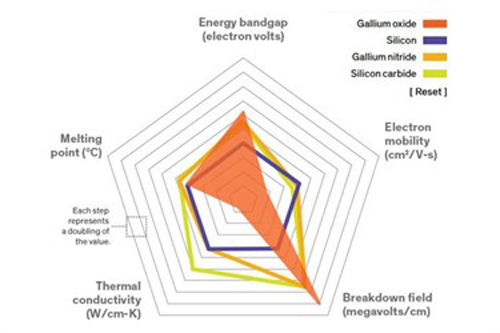
According to research by Japanese startup, Flosfia, gallium oxide could replace silicon as the best material for use in electronic components such as diodes and transistors as it is cheaper, more efficient and capable of handling high voltages.

According to research by Japanese startup, Flosfia, gallium oxide could replace silicon as the best material for use in electronic components such as diodes and transistors as it is cheaper, more efficient and capable of handling high voltages.
Although this weakness is addressed by devices made from silicon carbide and gallium nitride, both have had limited commercial success due to high prices. Flosfia claims that its gallium oxide diodes are already performing more efficiently than those made from SiC and GaN.
The superiority of these gallium oxide devices stems from the material's approximately 5eV bandgap—higher than that of gallium nitride (about 3.4 eV) or silicon carbide (about 3.3 eV). A bigger bandgap enables a material to withstand a stronger electric field, making it possible to use a thinner device for a given voltage. The thinner the device, the lower its resistance, and thus the more efficient it is.
Gallium oxide devices do not excel in all areas. Their Achilles' heel is poor thermal conductivity. Flosfia's engineers have improved the device architecture to address that very issue. In particular, they found a way to make the diode chip thinner, according to Naonori Kurokawa, a partner at University of Tokyo Edge Capital, a Flosfia investor. The key is to grow the gallium oxide crystal on a sapphire substrate.
The process Flosfia uses for making gallium oxide devices was invented by company cofounder and Kyoto University professor Shozuo Fujita. In it, the sapphire substrate is heated and a fine mist of particles is transferred into the chamber via a nonreactive 'carrier gas'. The mist, which contains metal compounds, decomposes when it hits the hot substrate and forms a film of gallium oxide. The whole process can be cycled through rapidly because, unlike with other methods, the chamber never has to be completely evacuated, driving down costs.
The Flosfia engineers found that their device combines a 531V breakdown voltage with an on-resistance of 0.1mO/cm2, exceeding the limits of what is possible with silicon carbide.
Kurokawa explains that the diodes have modest breakdown voltages because they are bare chips. Introducing insulating layers into this very simple device should lead to significant improvement, he said.
Flosfia aims to provide samples of its diodes to potential customers later in 2016 with a ramp-up of diode production in 2018 and the development and launch of accompanying transistors.